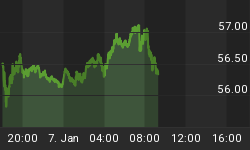It is no surprise that investor sentiment has turned bearish following this week's price action. Mysteriously, lower prices somehow makes investors turn into bears. The "dumb money" indicator is bearish, and this is a bullish signal (see more below). Insiders are buying to a degree not seen since March, 2009. The Rydex market timers are neutral but showing signs of becoming more bearish.
As I have detailed recently and over the past couple of years, the best time to get long the market (on average) is following 2 consecutive weeks of bearish sentiment. This is week #1. (See this article: What do the Numbers Say?). The numbers support the notion that you should be buying when others are bearish, but please understand that it doesn't always work out that way. Now I state these caveats not to hedge myself or the analysis, but to get the readers to understand that this is no holy grail. (See this article: Are you Looking for the Holy Grail?) There are risks. In any case, I would rather be a buyer here than 15% a go, and I believe the data is on my side.
Several other points are worth noting. One, failed signals are an ominous sign of significantly lower prices. I would consider the recent bull signal (see the June 12, 2011 commentary) a failed signal (see A Floor has Been Set), and the results speak for themselves. Two, this is a bear market until proven otherwise; therefore, this is a counter trend trade, and it may require some nimbleness to extract profits. Three, not all the sentiment indicators are in alignment, and it should be noted that the best market bottoms leading to the most sustainable prices moves occur when the "dumb money" and Rydex market timers are bearish and insiders are bullish. We are still waiting for the Rydex market timers to get more bearish.
The "Dumb Money" indicator (see figure 1) looks for extremes in the data from 4 different groups of investors who historically have been wrong on the market: 1) Investors Intelligence; 2) MarketVane; 3) American Association of Individual Investors; and 4) the put call ratio. This indicator shows extreme bearish sentiment, and this will be a bull signal.
Figure 1. "Dumb Money"/ weekly
Figure 2 is a weekly chart of the SP500 with the InsiderScore "entire market" value in the lower panel. From the InsiderScore weekly report: We issued a special Macro Overview Report this morning explaining that our key quantitative macro buy signal - the Industry Buy Inflection - was triggered in our major macro groups and seven of ten sectors. The signals came after insider buying volumes surged to their highest level since March 2009 and as insider selling waned.
Figure 2. InsiderScore "Entire Market" value/ weekly
Figure 3 is a weekly chart of the SP500. The indicator in the lower panel measures all the assets in the Rydex bullish oriented equity funds divided by the sum of assets in the bullish oriented equity funds plus the assets in the bearish oriented equity funds. When the indicatoris green, the value is low and there is fear in the market; this is where market bottoms are forged. When the indicator is red, there is complacency in the market. There are too many bulls and this is when market advances stall.Currently, the value of the indicator is 54.74%. Values less than 50% are associated with
market bottoms. Values greater than 58% are associated with market tops.
Figure 3. Rydex Total Bull v. Total Bear/ weekly
Let me also remind readers that we are offering a 1 month FREE TRIAL to our Premium Content service, which focuses on daily market sentiment and the Rydex asset data. This is excellent data based upon real assets not opinions, and it has been very helpful as the market has been forming a top. Interestingly, I have had only a few subscribers take me up on this free offer. Amazing!
















